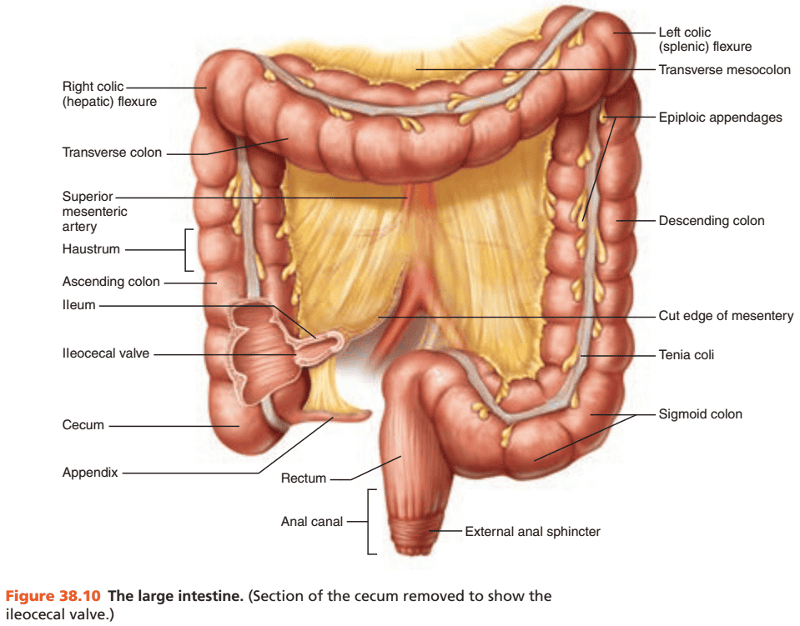The digestive system provides the body with what 3 general substances?
1. Nutrients
2. Water
3. Electrolytes
The organs of the digestive system does what 4 general functions?
1. Ingest food
2. Digest food
3. Absorb food
4. Eliminate undigested remains as feces
The digestive system extends from and to which body parts?
Extends from the mouth to the anus
How is ingested food made available to body cells? (Hint: describe the 2 ways that must occur in sequential order)
1. Digestion
2. Absorption
Describe digestion.
Ingested food being broken down into smaller diffusible molecules
Describe absorption.
Digested end products pass through epithelial cells lining the tract into the blood for distribution to the body cells
The organs of the digestive system are separated into what 2 major groups?
1. Alimentary canal aka gastrointestinal (GI) tract
2. Accessory digestive organs
The alimentary canal consists of what 6 body features?
1. Mouth
2. Pharynx
3. Esophagus
4. Stomach
5. Small intestines
6. Large intestines
The accessory digestive organs consist of what 5 structures?
1. Teeth
2. Salivary glands
3. Gallblader
4. Liver
5. Pancreas
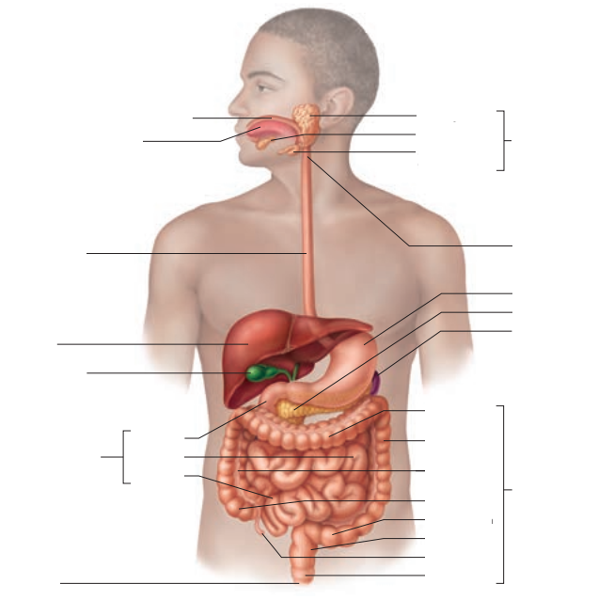
1. Identify the blanks.
2. Also Identify the accessory organs and the alimentary canal organs.
3. Is the spleen an organ of the digestive system? If no, explain which system it belongs to.
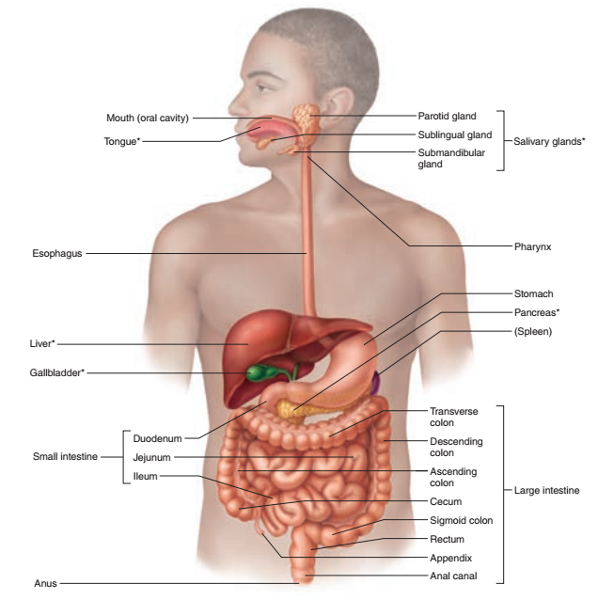
1. Look at the picture.
2. Asterisks are accessory organs. Those without asterisks are alimentary canal organs.
3. No. The spleen belongs to the lymphatic system.
What is the genearl function of the teeth?
Physically break down foods
The salivary glands, gallbladder, liver, and pancreas secrete their products into where?
Into the alimentary canal
Describe the basic structure of the alimentary canal from the esophagus to the anal canal.
Similar
The alimentary canal wall has how many layers aka tunics?
4
What are the 4 layers of the alimentary canal from the lumen outward?
1. Mucosa
2. Submucosa
3. Muscularis externa
4. Serosa (*adventitia in the esophagus since it is located outside of the peritoneal cavity)
The mucosa layer of the alimentary canal has how many subdivisions?
3
What are the 3 subdivisions of the mucosa layer of the alimentary canal from innermost to outermost?
1. Epithelium
2. Lamina propria
3. Muscularis mucosae
What are the 2 tissue types in the epithelium of the alimentary canal? (Hint: mouth+esophagus+anus and the remainder of the canal)
1. Mouth+esophagus+anus=stratified squamous epithelium
2. Remainder of the canal=simple columnar epithelium
What is the tissue type of the lamina propria, and what vessels and follicles does that tissue type contain?
Areolar connective tissue containing blood vessels and lymphoid follicles
What are the 3 functions of the mucosa? (Hint: One function has 3 secretions)
1. Secretion of mucus, digestive enzymes, and hormones
2. Absorption of end products into the blood
3. Protection against infectious diseases
The submucosa layer of the alimentary canal has how many subdivisions?
0
The submucosa layer of the alimentary canal is made up of what 2 tissues that contain which 2 vessels and what type of fibers?
Areolar and dense irregular connective tissue containing blood vessels, lymphatic vessels, and nerve fibers
Which tunic is the submucosal nerve plexus located?
In the submucosa
What are the 2 functions of the submucosa layer of the alimentary canal? (Hint: Functions of blood vessels and elastic fibers)
1. Blood vessels absorb and transport nutrients
2. Elastic fibers help maintain the shape of each organ
The muscularis externa layer of the alimentary canal has how many subdivisions?
2
What are the 2 subdivisions of the muscularis externa layer of the alimentary canal (from innermost to outermost)?
1. Circular layer
2. Longitudinal layer
What are the 2 functions of the muscularis externa layer of the alimentary canal?
1. Segmentation of digested food along the tract
2. Peristalsis of digested food along the tract
Segmentation and peristalsis by the muscularis externa layer of the alimentary canal are controlled by what nerve plexus?
Myenteric nerve plexus
1. Which tunic is the myenteric nerve plexus located?
2. Which subdivision of the aforementioned tunic is the meyenteric nerve plexus located?
1. The muscularis externa
2. The circular layer
The serosa of the alimentary canal is composed of how many subdivisions?
2
What are the 2 subdivisions of the serosa from innermost to outermost? (Hint: One is a tissue type)
1. Connective tissue
2. Epithelium
What are the tissue type and epithelium that make up the serosa of the alimentary canal?
1. Areolar connective tissue
2. Simple squamous epithelium
What is the function of the serosa of the alimentary canal?
Reduces friction as the digestive system organs slide across one another
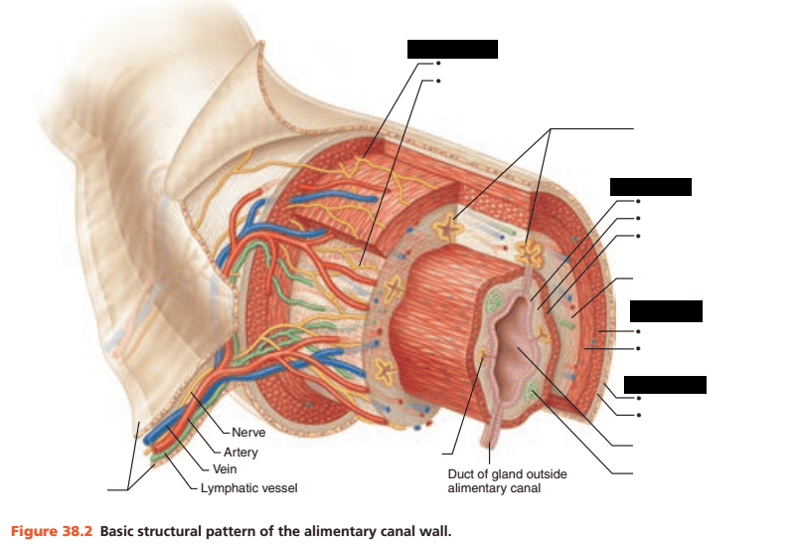
Identify the blanks
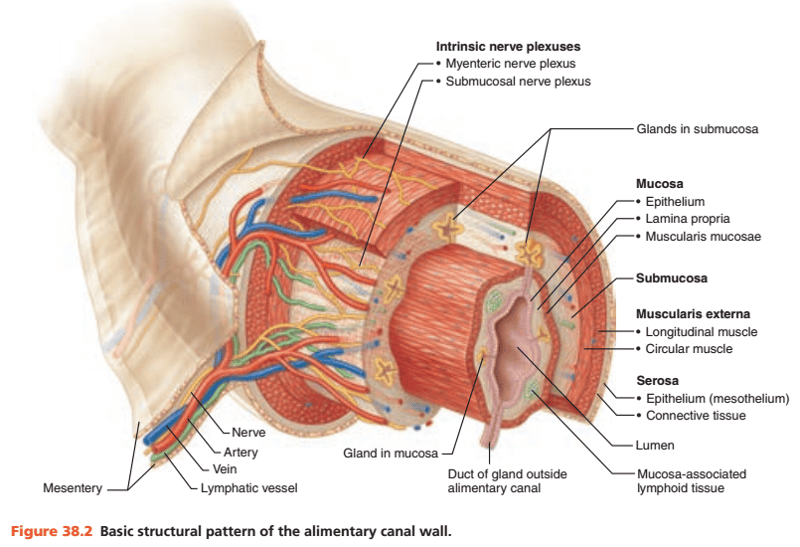
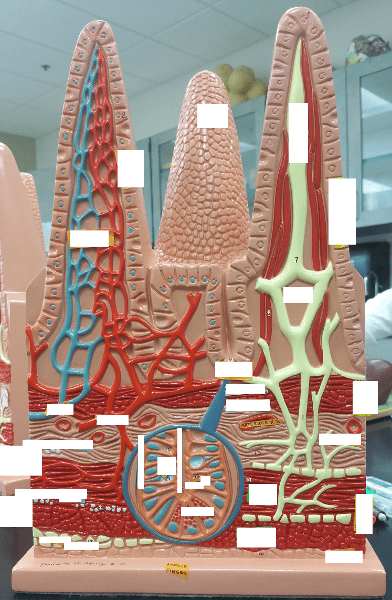
Identify the blanks
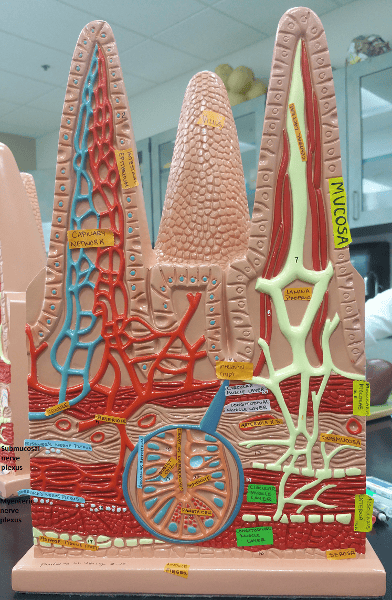
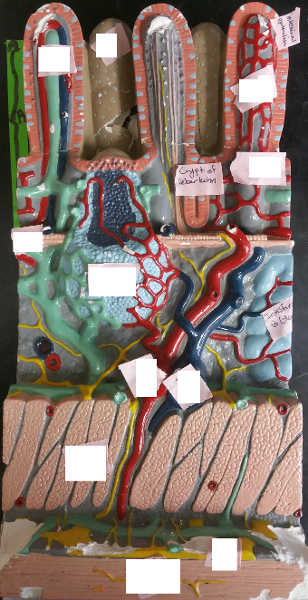
Identify the blanks.
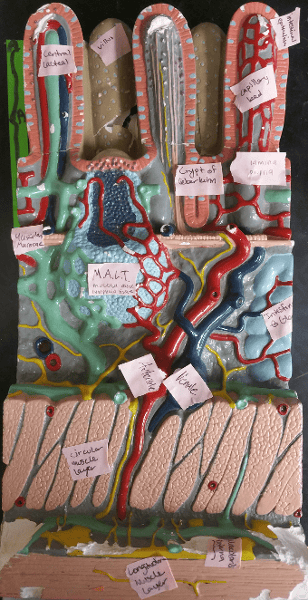
Food enters the mouth through which cavity?
Oral cavity
The oral cavity is commonly called what?
Mouth
The oral cavity is filled with what?
Mucous
The oral cavity is lined with what 4 digestive accessory structures?
1. Gums
2. Teeth
3. Tongue
4. Openings of the ducts of the salivary glands
What protects the opening of the oral cavity anteriorly?
Lips
What forms the lateral walls of the oral cavity?
Cheeks
What forms the roof of the oral cavity?
Palate
The anterior portion of the palate is referred to as what?
Hard palate
Why is the hard palate referred to by that name? (Hint: 2 bones underlie it)
The palatine processes of the maxillae and the palatine bones underlie it
What is the posterior portion of the palate?
Soft palate
1. The soft palate is what type of structure?
2. Is the soft palate supported by bone?
1. Fibromuscular structure
2. No
The floor of the oral cavity is occupied by what organ?
Tongue
The tongue is supported by what specific muscle?
Mylohyoid muscle
What secures the inferior midline of the tongue to the floor of the mouth?
Lingual frenulum
The space between the lips and cheeks and the teeth and the gums is called what?
Oral vestibule
What is the area that lies within the teeth and gums?
Oral cavity proper
On each side of the mouth at its posterior end are masses of lymphoid tissue called what?
Palatine tonsils
The palatine tonsils are bounded anteriorly and posteriorly by what 2 membranes? (Hint: think arches)
1. Anteriorly: Palatoglossal arch
2. Posteriorly: Palatopharyngeal arch
The mass of lymphoid tissue that covers the base of the tongue is called what?
Lingual tonsil
The tonsils are part of which body system?
The body's defense system
What is tonsillitis?
Inflammation of the palatine tonsils
Inflammation causes what to happen to the palatine tonsils?
Enlargement
Tonsilitis blocks entrance to what specific region?
Blocks entrance to the pharynx posteriorly
Describe tonsilitis's effect on swallowing?
Makes it difficult and paintful
How many salivary glands are there? (Hint: think pairs)
3 pairs of salivary glands
The salivary glands secrete what specific substance?
Saliva
Saliva is duct by the salivary glands into which cavity?
Oral cavity
Describe the function of salivary amylase, one component of saliva.
Begins the digestion of starchy foods within the oral cavity
What 2 things happen to food as it enters the mouth?
1. Mixed with saliva
2. Masticated aka chewed
What is the function of the cheeks and lips in regards to food that is in the mouth?
Hold the food between the teeth during mastication
What are the 2 functions of the tongue in regards to food that is in the mouth?
1. Manipulates the food
2. Initiates swallowing
What 2 breakdowns of food begins in the oral cavity?
1. Mechanical breakdown
2. Chemical breakdown
The Pharynx
The Pharynx
When the tongue initiates swallowing, the food passes posteriorly into which oral cavity feature?
Pharynx
The pharynx is divided into what 3 parts?
1. Nasopharynx
2. Oropharynx
3. Laryngopharynx
The nasopharynx is located behind which cavity?
Nasal cavity
1. The oropharynx is located behind which cavity?
2. The oropharynx extends from what to what? (Hint: palate to what feature)
1. Oral cavity
2. Soft palate to the epiglottis
The laryngopharynx extends from what to what?
From the epiglottis to the larynx
The walls of the pharynx consist of how many layers of what muscle type?
2 layers of skeletal muscles
Describe the makeup of the 2 layers of the pharynx.
1. Inner layer of longitudinal muscle
2. Outer layer of circular constrictor muscles
The outer layer of circular constrictor muscles in the pharynx has what function?
Initiate wavelike contractions that propel food inferiorly into the esophagus
Aka as peristalsis
Does the pharynx have a mucosa?
Yes
The mucosa of the pharynx is composed of what epithelium?
Stratified squamous epithelium
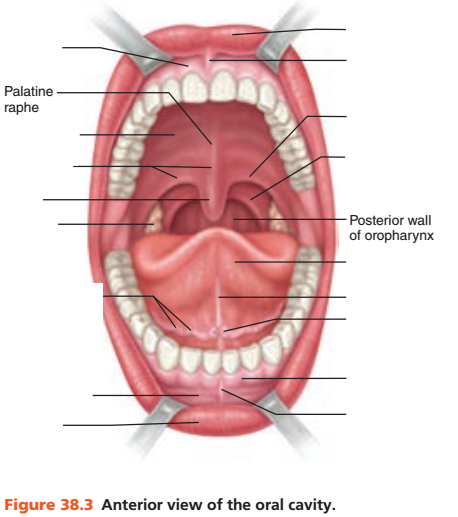
Identify the blanks.
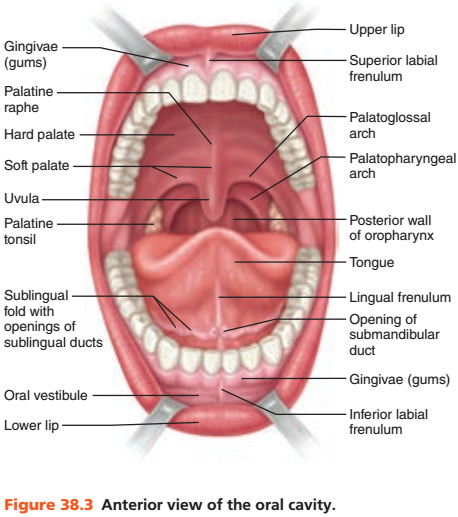
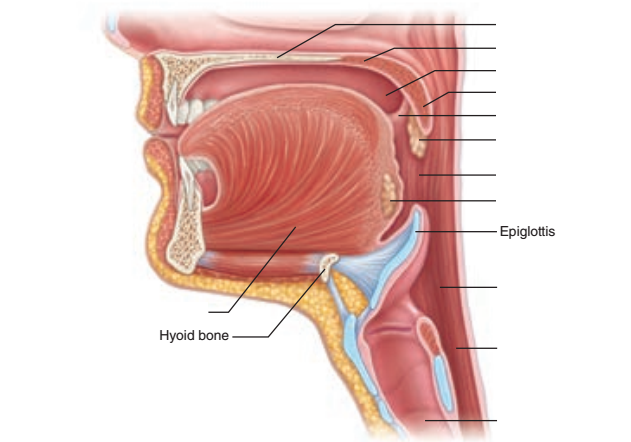
Identify the blanks.
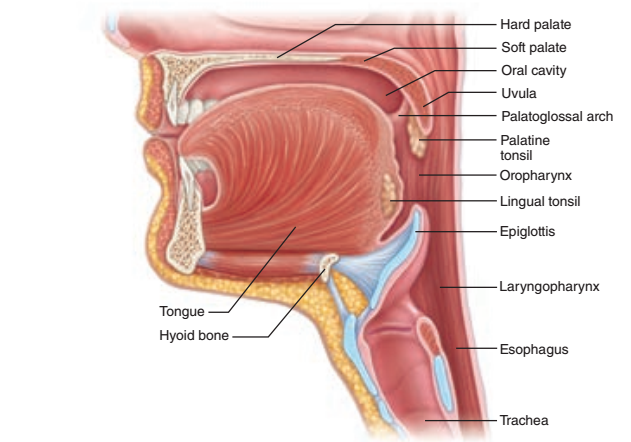
The Esophagus
The Esophagus
Any organ that is part of the alimentary canal has the 4 common tunics or layers, mucosa, submucosa, muscularis externa, serosa (from innermost to outermost).
Since the esophagus is outside the peritoneal cavity, its serosa is replaced by what?
Adventitia
The adventitia of the esophagus is made up of what type of tissue?
Areolar connective tissue
What is the function of the adventitia of the esophagus?
Binds the esophagus to the surrounding tissues
The esophagus extends from where, passes through which organ, and stops at which structure? (Hint: ends at a specific sphincter)
Extends from the pharynx through the diaphragm to the gastroesophageal sphincter
The esophagus conducts food to the stomach in what type of motion?
Peristaltic wavelike motion
The esophagus is devoid of what 2 functions?
1. Digestion
2. Absorption
The walls at the superior end of the esophagus contains what type of muscle?
Skeletal muscle
As the esophagus approaches the stomach, the skeletal muscle in its walls are replaced by what muscle type?
Smooth muscle
The gastroesophageal sphincter is made up of what muscle type?
Smooth muscle
Where is the gastroesophageal sphincter located? (Hint: junction)
At the esophagus-stomach junction
What is the function of the gastroesophageal sphincter?
Controls passage of food into the stomach
The Stomach
The Stomach
The stomach is located on what side of the abdominal cavity and hidden by what 2 organs?
Located on the left side of the abdominal cavity and is hidden by the liver and diaphragm
The stomach is broken up into what 4 important regions?
1. Cardial part
2. Fundus
3. Body
4. Pyloric part
What enters the cardial part of the stomach?
Food
What is the largest region of the stomach?
The body
What region forms the distal stomach?
The pyloric part
The pyloric part is broken up into what 4 parts?
1. Pyloric antrum
2. Pyloric canal
3. Pylorus
4. Pyloric sphincter
The pylorus is continuous with what organ?
The small intestine
What is the function of the pyloric sphincter?
Controls the emptying of the stomach
The pyloric sphincter empties into what organ?
The small intestine
What is the mesentery?
Double layer of the peritoneum that extends from the digestive organs to the body wall
What are the 2 mesenteries?
1. Greater omentum
2. Lesser omentum
The 2 mesenteries connect to what organ?
Stomach
The lesser omentum extends from what organ to what feature of the stomach?
Extends from the liver to the lesser curvature of the stomach
The greater omentum extends from what feature of the stomach and covers how many organs?
Extends from the greater curvature of the stomach and covers most of the abdominal organs
How long does the stomach store food?
Temporarily
The stomach is the site for what 2 breakdowns of food?
1. Chemical breakdown
2. Mechanical breakdown
What is the innermost muscularis externa layer of the stomach?
Oblique smooth muscle
What are the 3 functions of the oblique layer of the stomach's muscularis externa?
1. Churn food
2. Mix food
3. Pummel food
Gastric glands of the stomach mucosa secrete what 2 secretions?
1. Hydrochloric acid
2. Hydrolytic enzymes
The mucosal glands of the stomach secrete what and what is it's function?
Secrete a mucus that prevents the stomach itself from being digested by the proteolytic enzymes
Most digestive activity occurs in what part of the stomach?
Pyloric part of the stomach
After the food is processed in the stomach, what is it called?
Chyme
How does chyme enter the small intestine? (Hint: through which sphincter?)
Enters the small intestine through the pyloric sphincter
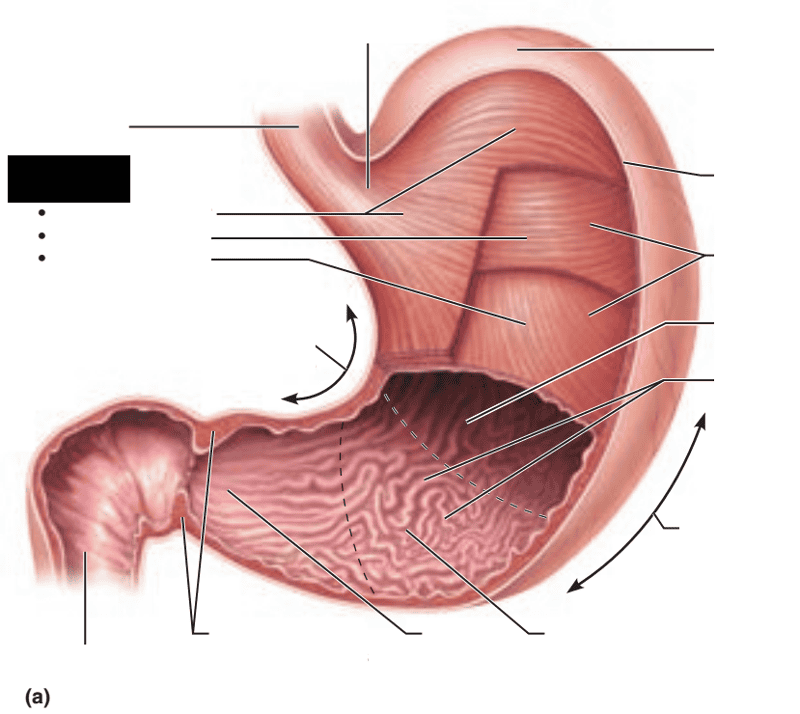
Identify the blanks.
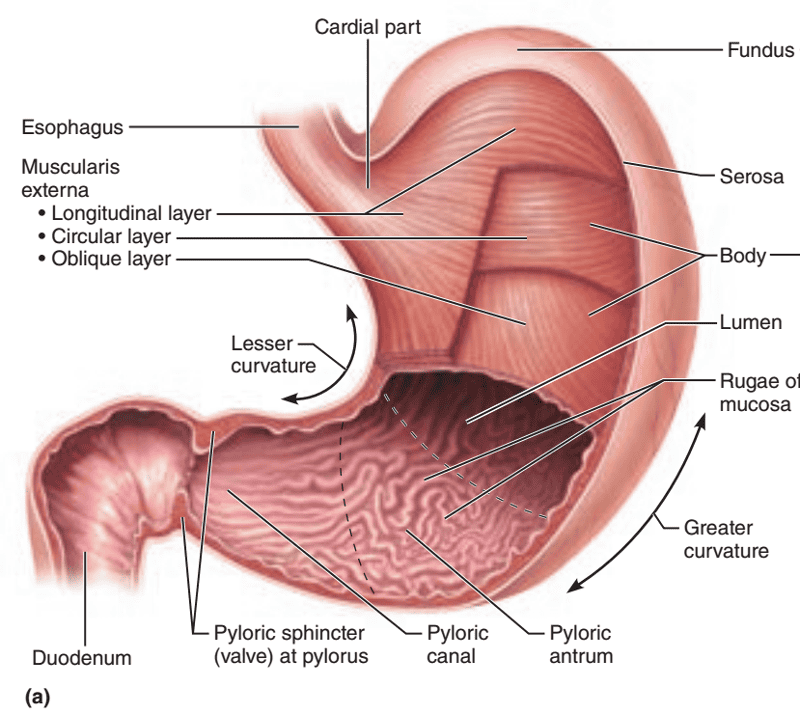
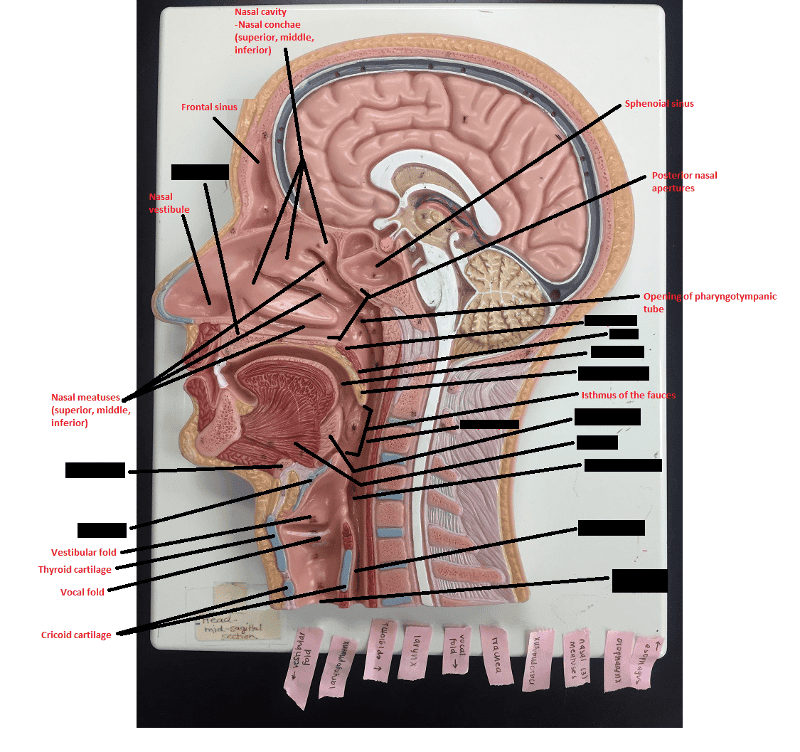
Identify the blanks.
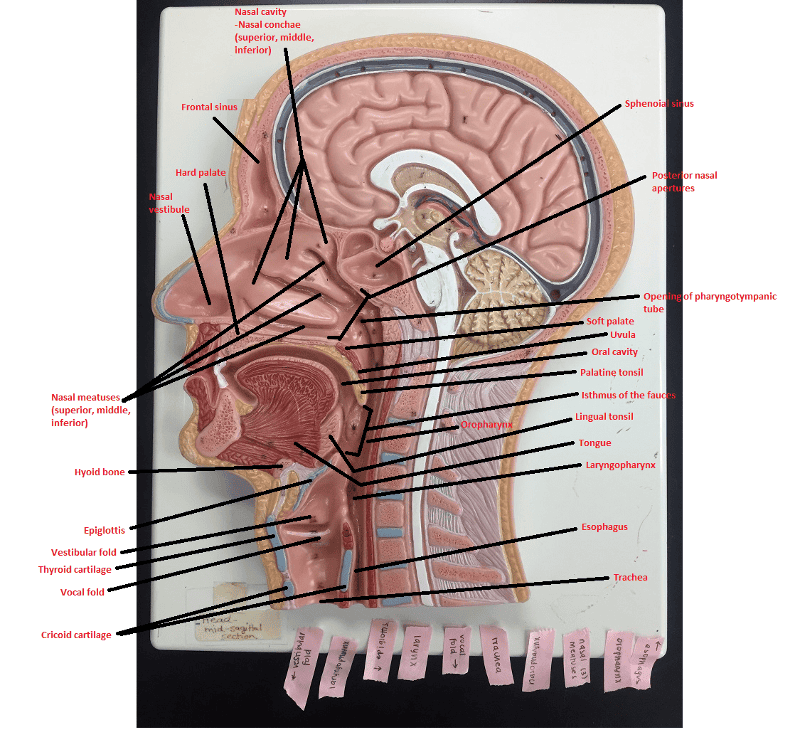
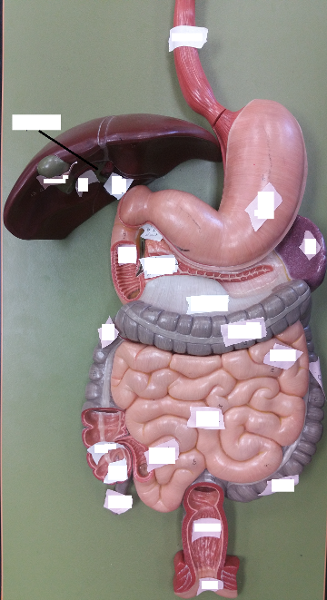
Identify the blanks.
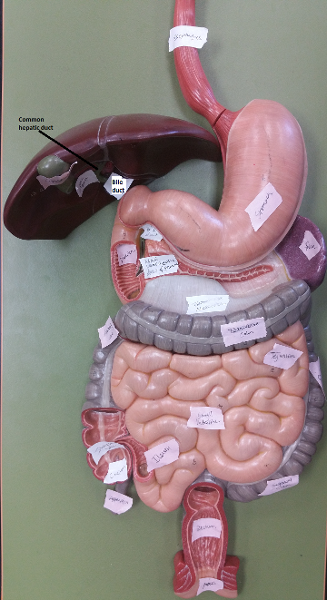
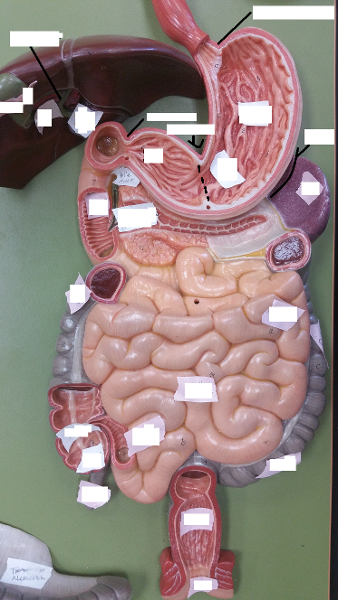
Identify the blanks.
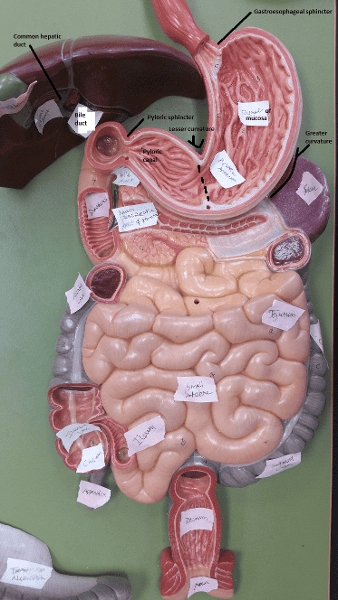
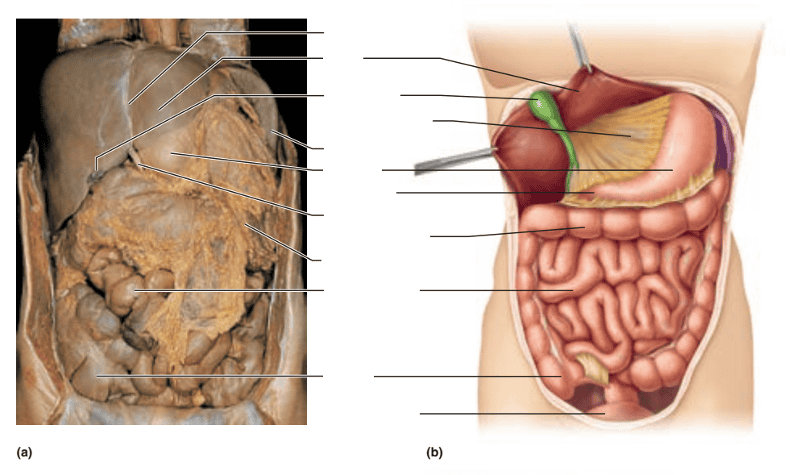
Identify the blanks.
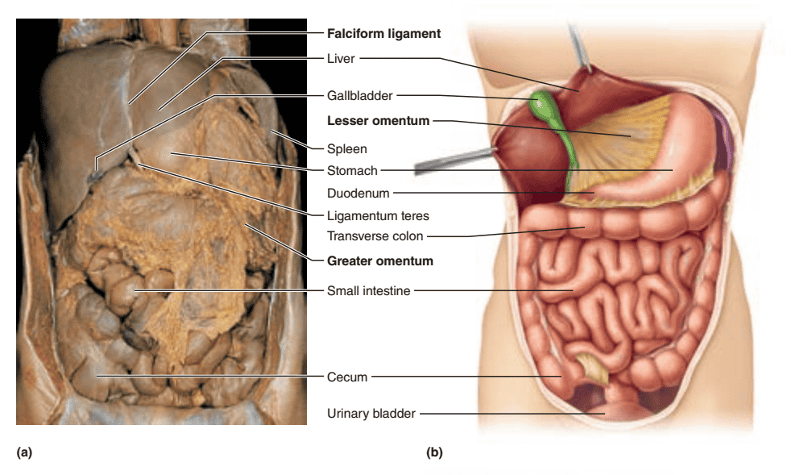
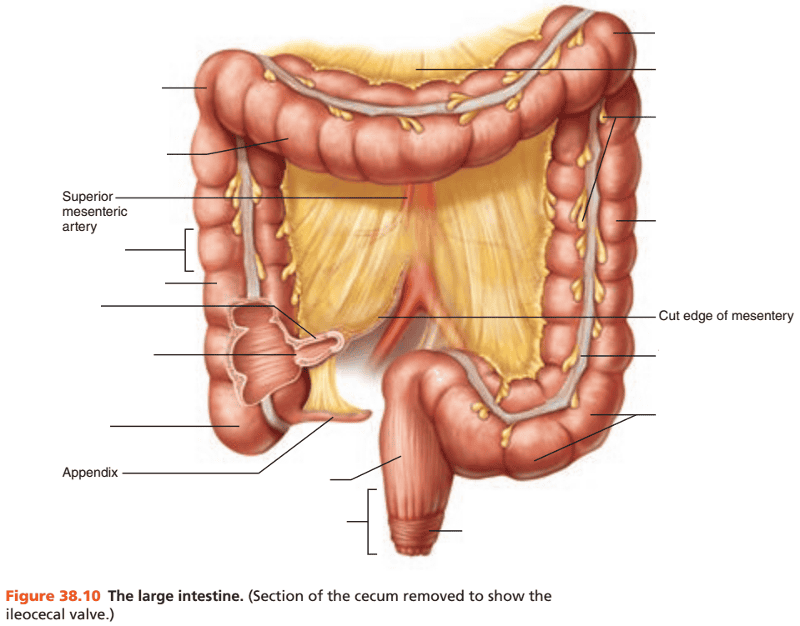
Identify the blanks.
